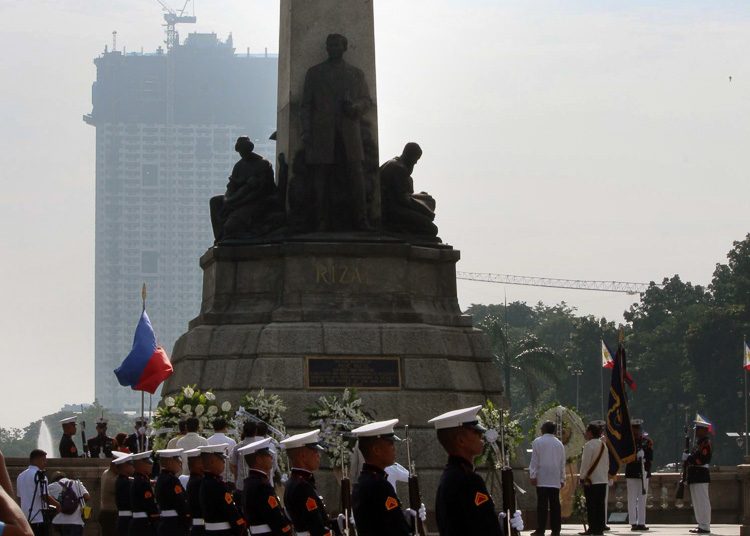SUMMARY
This is AI generated summarization, which may have errors. For context, always refer to the full article.

MANILA, Philippines (UPDATED) – In the 4th round of oral arguments on the controversial Torre de Manila condominium, a Supreme Court (SC) justice said on Tuesday, August 18, that the rule of law was not followed when the Manila city government granted permits for the construction of the 49-story building.
Citing excerpts from Ordinance No. 8119, or the Manila zoning ordinance, SC Associate Justice Francis H. Jardeleza said that 4 layers of protection were ignored when DMCI Homes, the condominium’s developer, was given the permits to build the high-rise residential project:
- Buildings under the university cluster, where the Torre de Manila stands, impose a maximum floor-area ratio of 4. Torre de Manila’s building plans show that it will have a floor-area ratio of 7.79.
- Section 22 of the ordinance prescribes building regulations in histo-cultural preservation zones.
- Section 23 states that the floor-area ratio requirement should be complied with “in all instances” and that the validity of this requirement will only be superseded by regulations specified for the zone.
- Section 47 requires a heritage impact statement to be submitted to the city planning and development office.
In his 3-hour interpellation of Manila city legal officer Jose Alberto Flaminiano, Jardeleza said that the rule of law was not followed despite the provisions in the ordinance.
Variance application
In June 2012, Manila city’s planning and development officer, Resty Rebong, approved the zoning permit for Torre de Manila.
Under Sections 60, 61, and 62 of the ordinance, real estate developers seeking exemptions from the prescribed allowable land use limits must apply for a variance, which should be approved by the city council.
But Flaminiano admitted that at the time the permits were granted, DMCI had not yet applied for a variance. The approval of the Manila Zoning Board of Adjustments and Appeals (MZBAA) came in 2014, two years after DMCI started construction.
Disregarded layers of protection
“According to your ordinance, you are obliged to enforce Section 23. If anyone wants to be excused from Section 23, what should they do?” Jardeleza asked.
“Apply for variance, your honor,” Flaminiano responded.
“Ergo, it seems that the rule of law was not followed. And that’s just in Section 23,” Jardeleza said.
Under the SC justice’s questioning, Flaminiano said that the city officials who issued the permits “acted beyond the scope of their authority.”
Jardeleza hit the city government’s decision to issue the zoning permit despite the limitations spelled out in the ordinance.
“Who gave that person the authority to disregard the 4 layers of protection?” he asked.
Approval of mayors
During the oral arguments, Flaminiano also told the court that in a conversation with Rebong, the latter said former Manila Mayor Alfredo Lim instructed the city government to process DMCI’s applications, and that documents “should not go through the city council” for the benefit of the developer.
During the term of current Manila Mayor Joseph Estrada, DMCI consulted city planning and developing officer Danilo Lacuna Jr on the process for applying for a variance.
Lacuna told Jardeleza that the mayor instructed him to “help the developer” go through the processes.
Asked what this meant, Lacuna said he took it to mean that the mayor “encourages developers to invest in the city.”
But he admitted that he forgot to inform DMCI to cite the section of the land use ordinance in its application.
“It was a lapse on my part. I forgot to tell them that they need to write an application citing a specific section,” he said.
Issued approvals
In last week’s oral arguments, Justice Marvic Leonen also questioned the zoning permit issued to DMCI, asking lawyer Victor Lazatin how they could have started construction of Torre de Manila even without a resolution from the city council or the MZBAA.
Lazatin replied that they saw no reason to go to the MZBAA because of the approval issued by the Manila city planning and development officer.
The High Court is hearing the September 2014 petition filed by the Knights of Rizal seeking to stop the construction of Torre de Manila because it destroys the “visual dominance” of the Rizal Monument.
The next round of oral arguments is set for August 25 at 3 pm. – Rappler.com
Add a comment
How does this make you feel?
There are no comments yet. Add your comment to start the conversation.